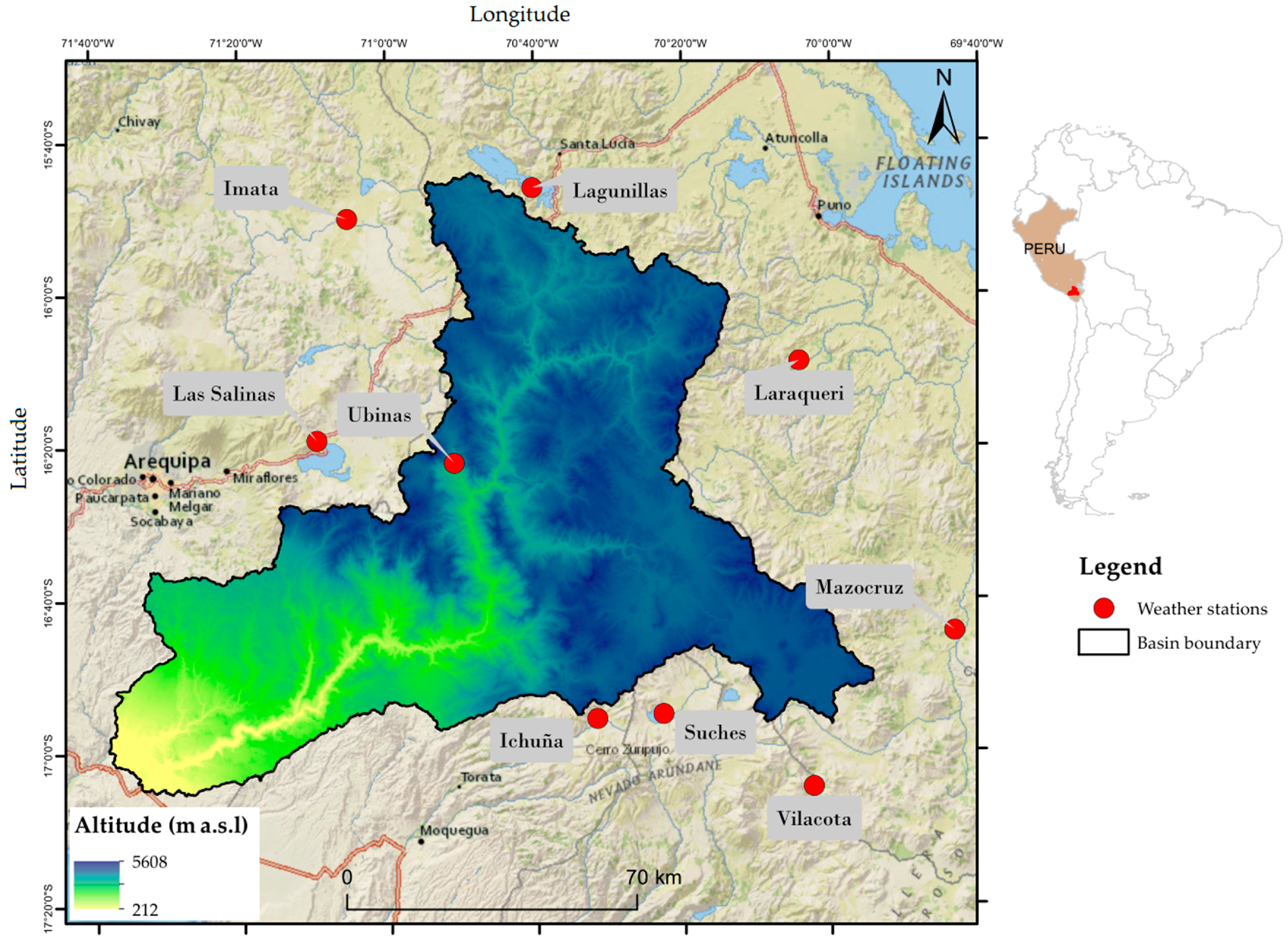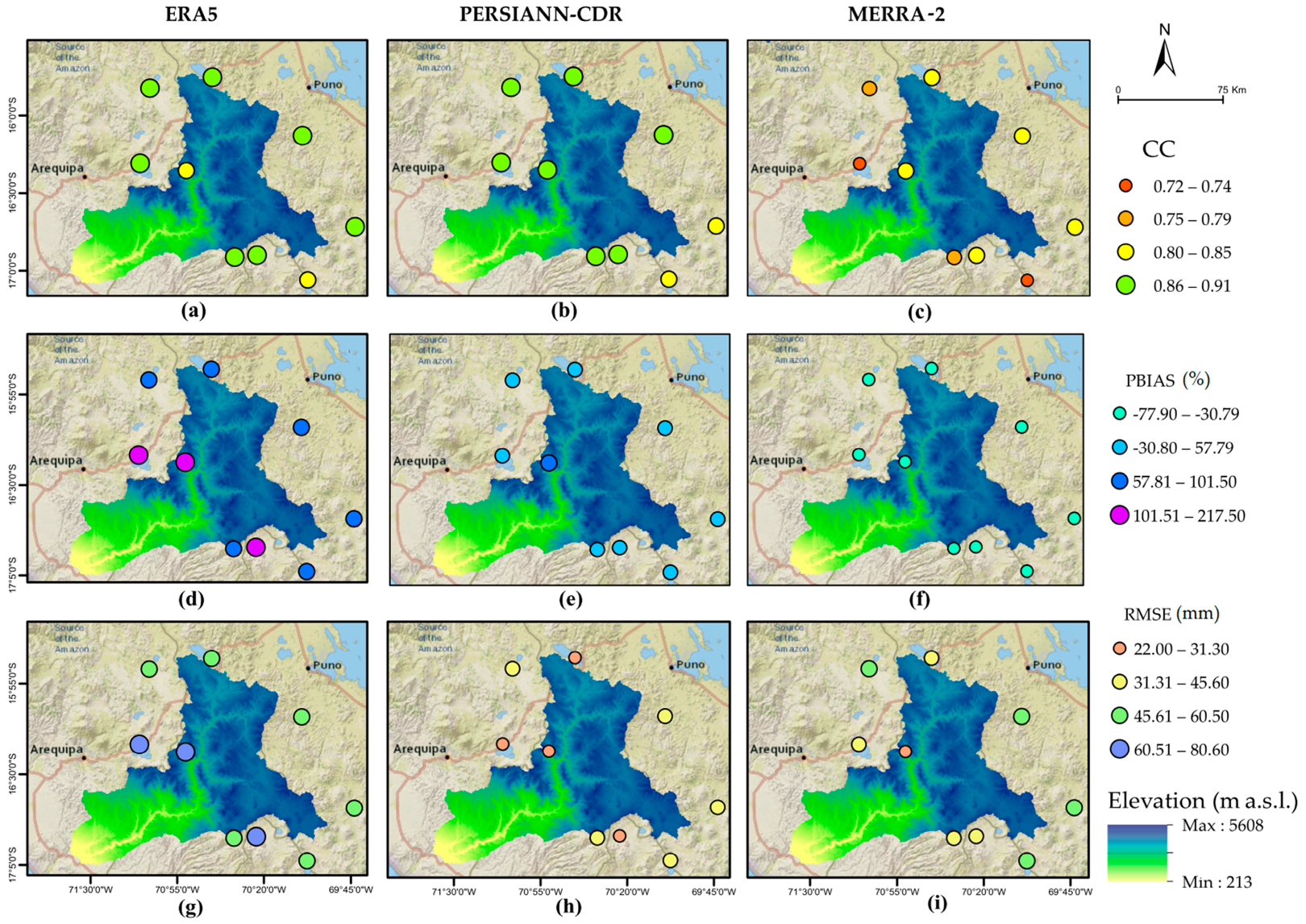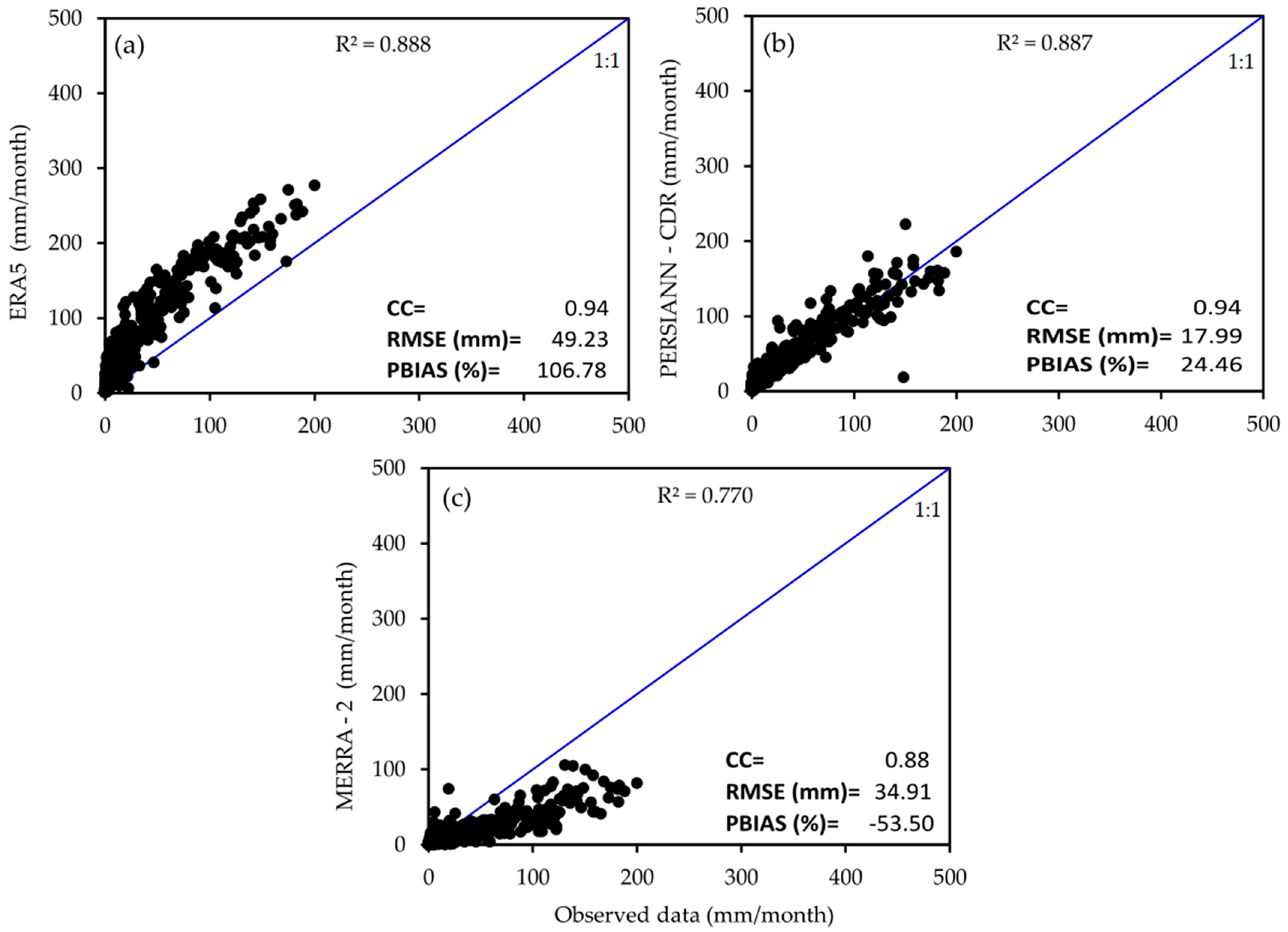Performance Evaluation of the ERA5, MERRA-2, and PERSIANN-CDR Gridded Products in the Tambo Basin †
Abstract
1. Introduction
2. Materials and Methods
2.1. Study Area
2.2. Terrain Data
2.3. Meteorological Data
2.4. Gridded Meteorological Data
2.5. Methodology
3. Results
3.1. Evaluation by Meteorological Station
3.2. Areal Average Evaluation
4. Discussion
5. Conclusions
Author Contributions
Funding
Institutional Review Board Statement
Informed Consent Statement
Data Availability Statement
Acknowledgments
Conflicts of Interest
References
- Araújo, P.A.A.; Silva, C.M.S.E.; Rodrigues, D.T.; Valentim, A.M. Analysis of Extreme Rainfall Events on a Sub-Daily Scale in Northeast. Environ. Sci. Proc. 2023, 25, 97. [Google Scholar] [CrossRef]
- Gehne, M.; Hamill, T.M.; Kiladis, G.N.; Trenberth, K.E. Comparison of Global Precipitation Estimates across a Range of Temporal and Spatial Scales. J. Clim. 2016, 29, 7773–7795. [Google Scholar] [CrossRef]
- Lavers, D.A.; Harrigan, S.; Andersson, E.; Richardson, D.S.; Prudhomme, C.; Pappenberger, F. A vision for improving global flood forecasting. Environ. Res. Lett. 2019, 14, 121002. [Google Scholar] [CrossRef]
- Kidd, C.; Becker, A.; Huffman, G.J.; Muller, C.L.; Joe, P.; Skofronick-Jackson, G.; Kirschbaum, D.B. So, How Much of the Earth’s Surface Is Covered by Rain Gauges? Bull. Am. Meteorol. Soc. 2017, 98, 69–78. [Google Scholar] [CrossRef]
- Sun, Q.; Miao, C.; Duan, Q.; Ashouri, H.; Sorooshian, S.; Hsu, K.-L. A Review of Global Precipitation Data Sets: Data Sources, Estimation, and Intercomparisons. Rev. Geophys. 2018, 56, 79–107. [Google Scholar] [CrossRef]
- Chawla, I.; Mujumdar, P.P. Evaluating rainfall datasets to reconstruct floods in data-sparse Himalayan region. J. Hydrol. 2020, 588, 125090. [Google Scholar] [CrossRef]
- Nguyen, T.H.; Masih, I.; Mohamed, Y.A.; Van der Zaag, P. Validating Rainfall-Runoff Modelling Using Satellite-Based and Reanalysis Precipitation Products in the Sre Pok Catchment, the Mekong River Basin. Geosciences 2018, 8, 5. [Google Scholar] [CrossRef]
- Ramirez Camargo, L.; Gruber, K.; Nitsch, F. Assessing variables of regional reanalysis data sets relevant for modelling small-scale renewable energy systems. Renew. Energy 2019, 133, 1468–1478. [Google Scholar] [CrossRef]
- Jiang, S.; Wei, L.; Ren, L.; Zhang, L.; Wang, M.; Cui, H. Evaluation of IMERG, TMPA, ERA5, and CPC precipitation products over mainland China: Spatiotemporal patterns and extremes. Water Sci. Eng. 2023, 16, 45–56. [Google Scholar] [CrossRef]
- Xu, X.; Frey, S.K.; Ma, D. Hydrological performance of ERA5 and MERRA-2 precipitation products over the Great Lakes Basin. J. Hydrol. Reg. Stud. 2022, 39, 100982. [Google Scholar] [CrossRef]
- Tan, M.L.; Santo, H. Comparison of GPM IMERG, TMPA 3B42 and PERSIANN-CDR satellite precipitation products over Malaysia. Atmos. Res. 2018, 202, 63–76. [Google Scholar] [CrossRef]
- Zhang, Y.; Wu, C.; Yeh, P.J.-F.; Li, J.; Hu, B.X.; Feng, P.; Jun, C. Evaluation and comparison of precipitation estimates and hydrologic utility of CHIRPS, TRMM 3B42 V7 and PERSIANN-CDR products in various climate regimes. Atmos. Res. 2022, 265, 105881. [Google Scholar] [CrossRef]
- Reichle, R.H.; Draper, C.S.; Liu, Q.; Girotto, M.; Mahanama, S.P.P.; Koster, R.D.; Lannoy, G.J.M.D. Assessment of MERRA-2 Land Surface Hydrology Estimates. J. Clim. 2017, 30, 2937–2960. [Google Scholar] [CrossRef]
- Vega-Durán, J.; Escalante-Castro, B.; Canales, F.A.; Acuña, G.J.; Kaźmierczak, B. Evaluation of Areal Monthly Average Precipitation Estimates from MERRA2 and ERA5 Reanalysis in a Colombian Caribbean Basin. Atmosphere 2021, 12, 11. [Google Scholar] [CrossRef]
- Lujano, E.; Diaz, R.D.; Tapia, B.; Lujano, A. Evaluación de Productos de Precipitación Satelital sobre la Cuenca del Lago Titicaca. Rev. Bras. Meteorol. 2023, 38, e38230078. [Google Scholar] [CrossRef]
- Xin, Y.; Lu, N.; Jiang, H.; Liu, Y.; Yao, L. Performance of ERA5 reanalysis precipitation products in the Guangdong-Hong Kong-Macao greater Bay Area, China. J. Hydrol. 2021, 602, 126791. [Google Scholar] [CrossRef]
- Gomis, J.C.; Rattayova, V.; Salazar-Galán, S.; Francés, F. Evaluation of ERA5 and ERA5-Land reanalysis precipitation datasets over Spain (1951–2020). Atmos. Res. 2023, 284, 106606. [Google Scholar] [CrossRef]
- Quagraine, K.A.; Nkrumah, F.; Klein, C.; Klutse, N.A.B.; Quagraine, K.T. West African Summer Monsoon Precipitation Variability as Represented by Reanalysis Datasets. Climate 2020, 8, 10. [Google Scholar] [CrossRef]
- Huntington, J.L.; Hegewisch, K.C.; Daudert, B.; Morton, C.G.; Abatzoglou, J.T.; McEvoy, D.J.; Erickson, T. Climate Engine: Cloud Computing and Visualization of Climate and Remote Sensing Data for Advanced Natural Resource Monitoring and Process Understanding. Bull. Am. Meteorol. Soc. 2017, 98, 2397–2410. [Google Scholar] [CrossRef]
- Hosking, J.R.M.; Wallis, J.R. Regional Frequency Analysis: An Approach Based on L-Moments; Cambridge University Press: Cambridge, UK, 1997. [Google Scholar]
- Espinoza, J.C. El Método Del Vector Regional de Índices Pluviométricos. 2005. Available online: https://pdfcoffee.com/el-metodo-del-vector-regional-de-indices-pluviometricos-9-pdf-free.html (accessed on 15 May 2024).
- Wong, J.S.; Razavi, S.; Bonsal, B.R.; Wheater, H.S.; Asong, Z.E. Inter-comparison of daily precipitation products for large-scale hydro-climatic applications over Canada. Hydrol. Earth Syst. Sci. 2017, 21, 2163–2185. [Google Scholar] [CrossRef]
- Hamza, A.; Anjum, M.N.; Masud Cheema, M.J.; Chen, X.; Afzal, A.; Azam, M.; Kamran Shafi, M.; Gulakhmadov, A. Assessment of IMERG-V06, TRMM-3B42V7, SM2RAIN-ASCAT, and PERSIANN-CDR Precipitation Products over the Hindu Kush Mountains of Pakistan, South Asia. Remote Sens. 2020, 12, 23. [Google Scholar] [CrossRef]
- Mahto, S.S.; Mishra, V. Does ERA-5 Outperform Other Reanalysis Products for Hydrologic Applications in India? J. Geophys. Res. Atmos. 2019, 124, 9423–9441. [Google Scholar] [CrossRef]
- Huang, L.; Mo, Z.; Liu, L.; Zeng, Z.; Chen, J.; Xiong, S.; He, H. Evaluation of Hourly PWV Products Derived From ERA5 and MERRA-2 Over the Tibetan Plateau Using Ground-Based GNSS Observations by Two Enhanced Models. Earth Space Sci. 2021, 8, e2020EA001516. [Google Scholar] [CrossRef]
- Clarke, R.T.; Buarque, D.C.; de Paiva, R.C.D.; Collischonn, W. Issues of spatial correlation arising from the use of TRMM rainfall estimates in the Brazilian Amazon. Water Resour. Res. 2011, 47, W05539. [Google Scholar] [CrossRef]
- Gaibor Velasco, N.I.; López Bravo, O.E.; Vallejo Ilijama, M.T.; Arreguín Samano, M. Análisis de la variabilidad climática utilizando producto satelital MERRA 2 para la microcuenca del Río Chazo Juan-Bolívar Ecuador. J. Sci. Res. Rev. Cienc. Investig. 2023, 8, 102–116. [Google Scholar]



| N° | Station | Latitude (°) | Longitude (°) | Altitude (m a.s.l.) |
|---|---|---|---|---|
| 1 | Mazocruz | −16.74 | −69.72 | 4003 |
| 2 | Vilacota | −17.08 | −70.04 | 4465 |
| 3 | Ubinas | −16.37 | −70.85 | 3380 |
| 4 | Ichuña | −16.14 | −70.54 | 3756 |
| 5 | Suches | −16.92 | −70.38 | 4452 |
| 6 | Laraqueri | −16.15 | −70.07 | 3970 |
| 7 | Las Salinas | −16.32 | −71.16 | 4378 |
| 8 | Lagunillas | −15.77 | −70.67 | 4200 |
| 9 | Imata | −15.84 | −71.09 | 4475 |
| Metric | Equation | Unit | Optimal Value |
|---|---|---|---|
| PBIAS | 0 | ||
| RMSE | 0 | ||
| CC | 1 |
Disclaimer/Publisher’s Note: The statements, opinions and data contained in all publications are solely those of the individual author(s) and contributor(s) and not of MDPI and/or the editor(s). MDPI and/or the editor(s) disclaim responsibility for any injury to people or property resulting from any ideas, methods, instructions or products referred to in the content. |
© 2025 by the authors. Licensee MDPI, Basel, Switzerland. This article is an open access article distributed under the terms and conditions of the Creative Commons Attribution (CC BY) license (https://creativecommons.org/licenses/by/4.0/).
Share and Cite
Apaza-Vilca, C.; Mamani-Yupanqui, M.L.; Lujano, E. Performance Evaluation of the ERA5, MERRA-2, and PERSIANN-CDR Gridded Products in the Tambo Basin. Environ. Earth Sci. Proc. 2025, 32, 17. https://doi.org/10.3390/eesp2025032017
Apaza-Vilca C, Mamani-Yupanqui ML, Lujano E. Performance Evaluation of the ERA5, MERRA-2, and PERSIANN-CDR Gridded Products in the Tambo Basin. Environmental and Earth Sciences Proceedings. 2025; 32(1):17. https://doi.org/10.3390/eesp2025032017
Chicago/Turabian StyleApaza-Vilca, Cristhian, Maria Liz Mamani-Yupanqui, and Efrain Lujano. 2025. "Performance Evaluation of the ERA5, MERRA-2, and PERSIANN-CDR Gridded Products in the Tambo Basin" Environmental and Earth Sciences Proceedings 32, no. 1: 17. https://doi.org/10.3390/eesp2025032017
APA StyleApaza-Vilca, C., Mamani-Yupanqui, M. L., & Lujano, E. (2025). Performance Evaluation of the ERA5, MERRA-2, and PERSIANN-CDR Gridded Products in the Tambo Basin. Environmental and Earth Sciences Proceedings, 32(1), 17. https://doi.org/10.3390/eesp2025032017






